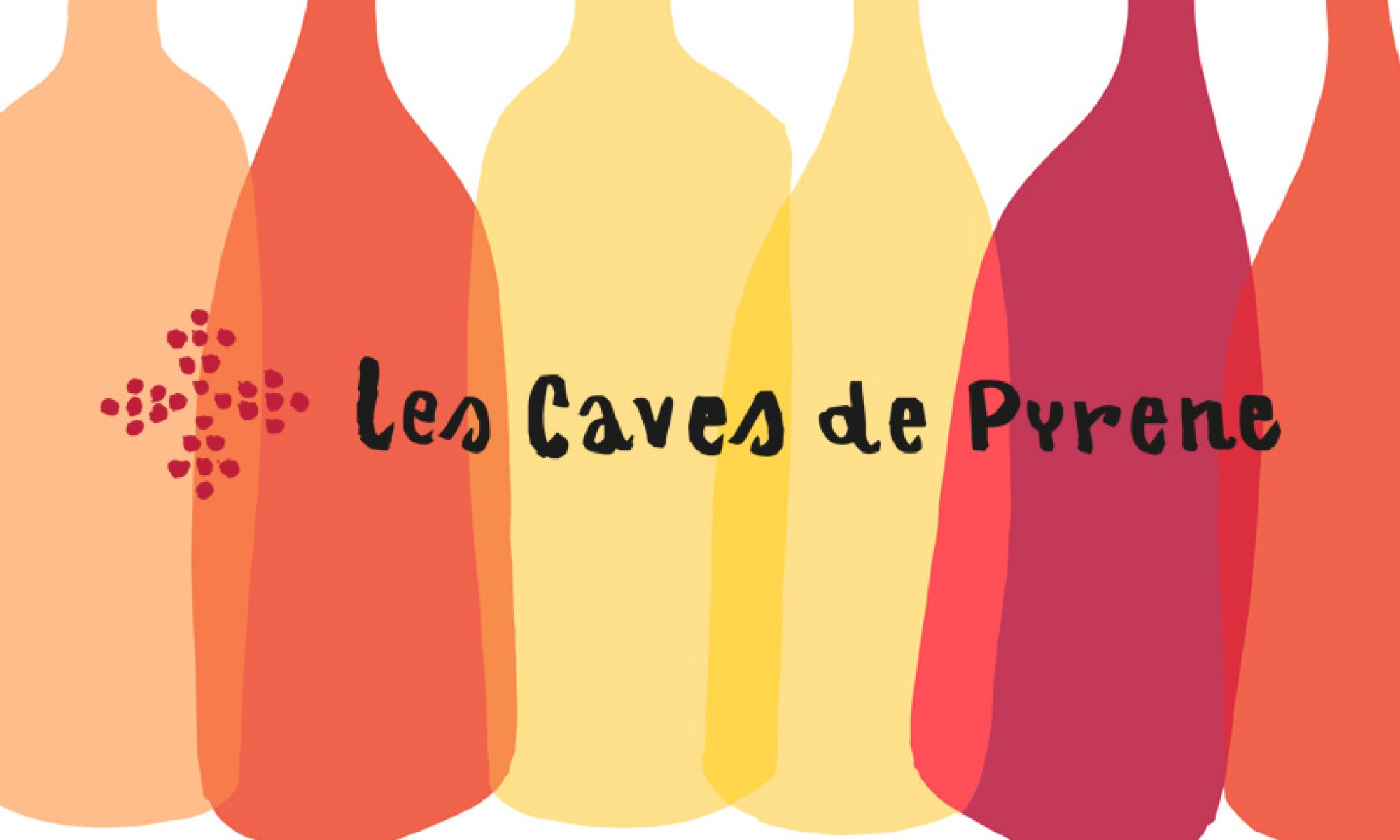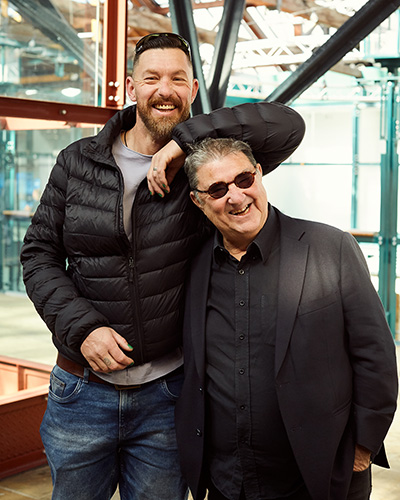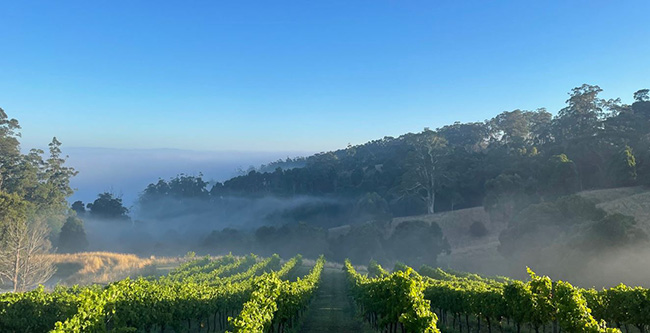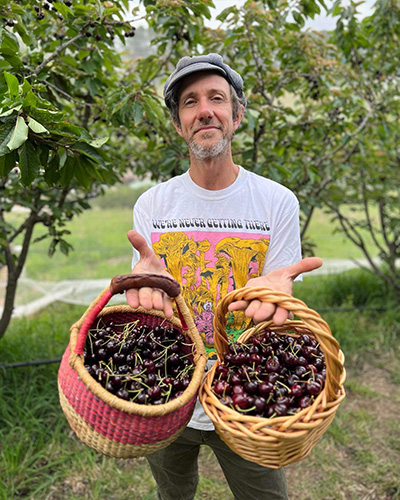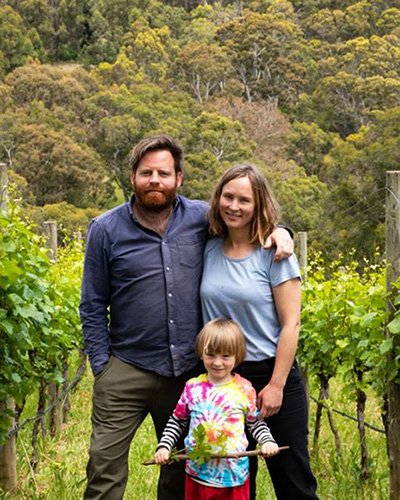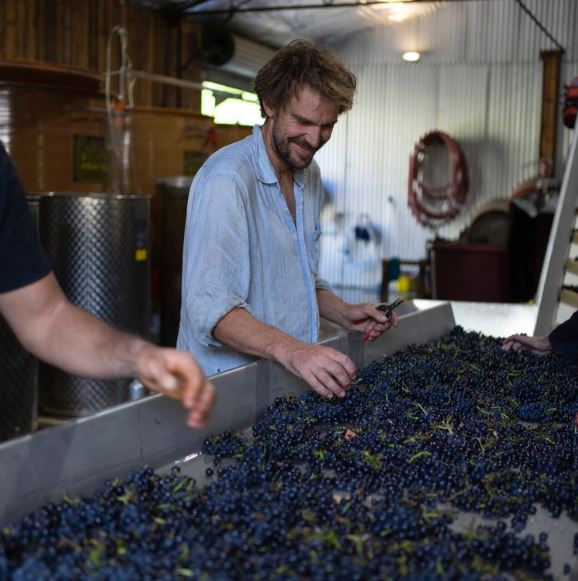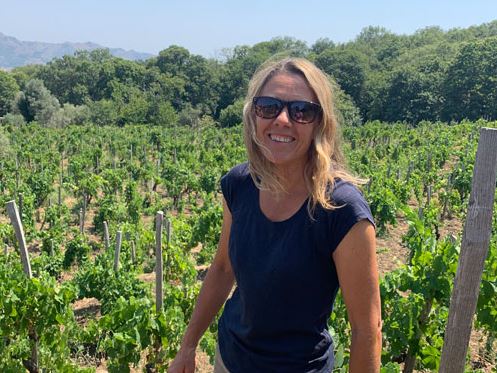It is a fact not universally acknowledged (and easily forgotten) that Les Caves has been rubbing shoulders with a notable and varied selection of wine wizards from Oz for quite some time. At the time of Rootstock and the whole bouncing Aussie natty wine mini revolution, we were getting into the crazy experiments from Natural Wine Selection Theory including the famous (infamous) Project Egg Runway 3 (a Hunter Valley Semillon conceived in a tiny ceramic egg and played music to in a shed off an airport runway). You had to be there. There was a refreshing innocence to the Aussie wine scene, almost a bootlegging mentality, an eagerness to experiment. We were very happy to be party to its performance artistry and loved when the producers themselves came over to the UK to hold court in their inimitable way (tastings around a campfire in a damp forest; barbecues by a loch-side…)
Times they have a-changed. Tastes change too. Things have settled down – even dampened down – somewhat in the land of Oz. Some producers are rowing back from their former naturalist positions and have abandoned wildness and wackiness, focusing instead on making “serious” (as they would see it) wines with a sense of place. Others are keeping the natural faith, trying to balance smashability with authenticity, whilst trying to improve the quality of farming that gives them their grapes.
Let’s look at the main Australian runners and riders on our list.
Castagna
Location: Beechworth, Victoria
Biodynamic certified
Julian and Alex Castagna are nothing if not uncompromising perfectionists. The Castagna wines from their biodynamically farmed vineyards in Beechworth (altitude x granite) are ones that reward patience and food. Everything is done by hand, with very little electricity. Hand harvesting leads to gentle crushing of whole clusters and some destemmed grapes. Fermentations take place at their own speed with native yeasts, pressing is done by hand with a basket press, and the wines are never fined or filtered. New oak is generally kept to a minimum. The results of Castagna’s approach truly speak for themselves. The wines clearly reflect both the soil and the season in which they are made as well as the vision of the person who has made them. The Castagna family is clearly making wines of philosophy and of place, and succeeding admirably, even as their wines defy the stereotypes of Australian wine as big, over-oaked, fruit bombs.
Genesis is a wonderful Syrah, leaning into the northern Rhone idiom, whilst the wines with a more Italian inflection – Adam’s Rib, Un Segreto and La Chiave – have firm tannic spines, fine balance, and excellent typicity.
Patrick Sullivan
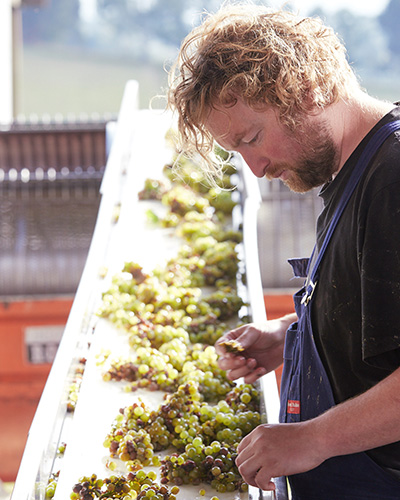
Location: Strzelecki Ranges. Gippsland
Biodynamic practising
Patrick has decidedly (and vocally) moved away from making natural wine and focused on developing wines that faithfully reflect the nature of the vineyards he is farming. Tumblestone Farm lies on 170 acres of prime Gippsland earth, at the base of the Strzelecki ranges. Half is virgin acacia forest, half a beautiful volcanic plain over sandstone, complete with a 90-year-old fruit orchard that was in desperate need of some care. The vineyards are organically dry-farmed with some biodynamic practices. The Chardonnays, with their roots in deep, rich volcanic soils, are whole cluster barrique-fermented and need time to digest the oak, but the underlying minerality in the wines suggests that they have excellent ageing potential. Patrick’s mission is quite simply to make some of the best Chardonnays in Australia!
Xavier Goodridge
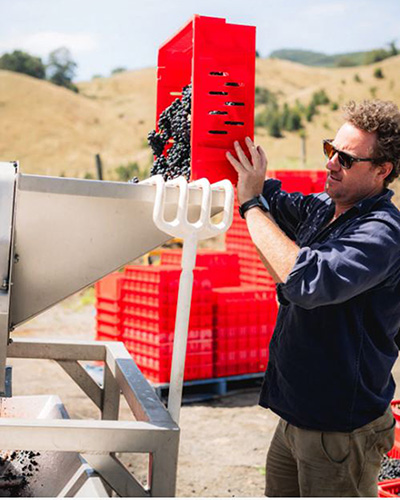
Location: Gippsland, Victoria
Organic practising
Xavier Goodridge crafts idiosyncratic expressions of Pinot Noir born on his organically farmed vineyard in Gippsland’s Maffra. In collaboration with exceptional growers from Mount Gambier and Henty, he sources the highest quality grapes for his Papa range. With the light touch in the winery, Xavier lets the wines speak of the land.
In 2018, Xavier acquired a long-term lease on a vineyard in Maffra. The vineyard, established back in 1987, is now at the end of its conversion to organic farming practices started by Xavier in the year he took over. Pursuing the organic transformation is a testament to his commitment to a sustainable approach in vine cultivation and winemaking and the purpose of producing exceptional wines that carry a unique sense of place.
The vineyard, covering a total of four hectares, is planted with 1 hectare dedicated to each Pinot Noir and Chardonnay, while the remaining two hectares has been grafted over to 3 clones of Pinot Noir. In Maffra, the soils bear mainly sandy loam light clay over a sandstone base and quartz with gravel throughout. For Xavier, soil health is of utmost importance as it forms the foundation, literally and figuratively, upon which the healthy environment for cultivating grapes of exceptional quality is built.
The winemaking style supports his philosophy of letting the vineyard’s work shine through in the finished wine.. His approach revolves around minimal intervention, allowing the grapes to express their natural characteristics without manipulation. Xavier’s ‘light touch’ on wines involves the wines fermenting spontaneously with no fining, filtration or additions except for small amounts of sulphur. Wines are usually raised in large-format old French oak, which allows them to mature gently and gracefully. This choice reflects his preference for a more restrained and harmonious integration of the vessel used, allowing the fruit to take centre stage. The result is a collection of wines that captivate the senses with their purity and lively energy.
Momento Mori & Nikau Farm
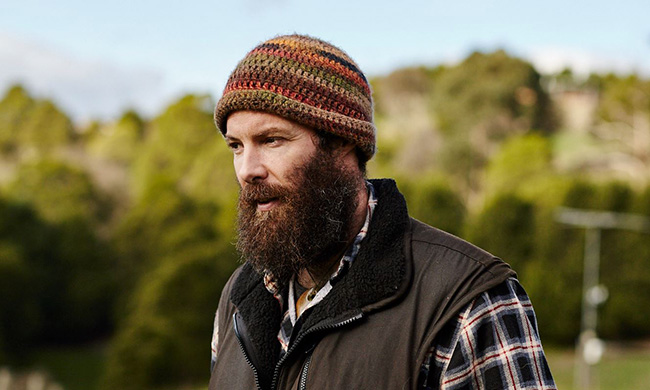
Region: Heathcote & Baw Baw Shire, Victoria
Practising organics
New Zealander Dane Johns (who staged with the great Bill Downie) worked many years as a barista in Melbourne where he learned about roasting and the nuances of blending and flavour infusion. He was also a musician, making electronic music and then moving towards the analogue version (much like his winemaking). He worked several vintages for Bress Winery in Victoria. The fruit for his Italian-themed wines is grown by the Chalmers Family Vineyard on the Mt Camel ranges in northern Heathcote. Experimental blocks were planted to around 30 different grape varieties (mostly Italian) a few years ago. Dane works closely with the Chalmers Family to achieve the quality of fruit they require each year. They are meticulous in the vineyard, using organic viticultural practices and have decades of knowledge growing alternative varieties in Australia. The wines are light and floral, the reds often pale verging on the rose-tinted, and the whites made with varying amounts of skin-contact. Brilliant and endlessly intriguing.
Nikau Farm is home to Dane Johns (of Momento Mori), his wife Hannah and their young family. It is an expansive property of about 95 acres in the Baw Baw region of Gippsland, Victoria. It sits high on a group of ranges in a place known to the indigenous peoples of this country as ‘Tolone.’
Dane and his family have had this property for four years now and in that period have established large vegetable gardens, mixed grazing animals, and flocks of ducks as well as chickens and other birds to increase the overall level of biodiversity. The property has two small plots (0.75h each) of vines on it, both about 27-years-old. Neither of these plots (or the farm as a whole) have ever been subjected to herbicides, inorganic fertilizer, and have been farmed organically since inception. They have of course continued to farm in this manner, adhering to strictly organic principles always with a philosophy of ‘less is more.’ Working with the flow of and within the cycles of nature is of paramount importance in every aspect of what they do on their property.
Jauma Wines
McLaren Vale, South Australia
Organic and biodynamic methods
James Erskine’s primary passion is working with Grenache (Pinot of the south!) from the McLaren Vale sub-appellation Blewitt Springs but given that he lives in the Adelaide Hills he also pays homage to, not Catalonia, but a few of the more interesting growers he has encountered there and produces a couple of locally grown wines. In the cellar, all ferments are wild and each vineyard’s wine is made without the addition of sulphur, enzymes, fining agents, acid or tannins. None of the wines are filtered or fined and no sulphur was added until bottling when a minimal addition is made to give James the confidence to ship his wines interstate and internationally. The cellar has multiple stories, so he can work using gravity rather than pumps. By trusting his own palate in the cellar rather than technical instruments he is able to follow and guide the will of each vineyard, the aim being to produce wines that capture both the essence of each vineyard and “my own personal, creative energies.”
The style of the reds has graduated from the broader and softer style of Grenache to its snappier and sappier alter ego. Meanwhile, whites have taken more of a headline role, particularly Chenin and Sauvignon (and even Arneis). James works with organic and BD grower friends. All the wines are unashamedly natural and generous, great fun, but not funky.
Gentle Folk
Region: Basket Range, Adelaide Hills, South Australia
Practising organic
A love of wine, food and growing things eventually led Gareth and Rainbo Belton away from their former careers involving scuba gear and the study of seaweed. Having fallen in love with the gastronomy and the people of the Adelaide Hills, they set up shop in the Basket Range to make the wines that they liked to drink, and thus work organically and biodynamically in the vines, and with as little intervention as possible in the winery. They don’t like to define their styles or wine making techniques, just make wine in the way they feel is right for the grapes and season, and with maximum drinkability and enjoyment in mind. Crushability is the name of the game especially with the Rainbow Juice (is it a white masquerading as a red, a rosé, or a bit of everything, and the equally enjoyable Vin de Sofa (play on the word Soif). The blends change every year, but the drinkability remains the same.
As well as these fruit-forward styles, Gareth also makes a range of wines to bring out the magnificent terroir of the Basket Range.
Commune of Buttons
Region: Basket Range, South Australia
Practising organic and regenerative farming
The Commune of Buttons is found in the Basket Range on a property called “Fernglen” with 150 years of agricultural history. Its 70-acres fills an undulating hidden valley with slopes of all aspects to the sun, and an average altitude of 350m asl. It is surrounded by hilltop stringybark forests on all side. The ancient soils comprise red clay with quartz, schist and ironstone rocks over a bed of sandstone. The 3.5 ha vineyards are a mix of Chardonnay, Pinot Noir and Nebbiolo planted between 1993-95. The high rainfall and absorbent clay soils allow for the mature vines to be dry grown in this region. The vineyards have been managed organically for over a decade and a programme of regenerative pruning has begun to ensure that the vines have a strong future. Chardonnay and Pinot Noir are the main focus (there is also a very delicious Nebbiolo) and are made in a very restrained style.
Nord-Sud
Region: Adelaide Hills, South Australia
Practising organic
Eric Narioo, who is somehow and somewhat familiar to us, and Anna Martens, made their first wine together on Mount Etna, Sicily in 2008. Since then, their small family wine estate, has grown to roughly 20-acres of old bush vine vineyards, olive groves and fruit and nut trees, scattered across the northern slopes of the active volcano. The wines are delicious, focused and energetic, and are now exported to many countries in the world.
In 2022, fuelled by the desire to spend more time with Anna’s family in Adelaide, the couple decided to start a small wine project based in the Adelaide Hills, while continuing with “Vino di Anna” on Mt Etna. The new project, called “Nord Sud,” aims to reflect the coming together of the northern hemisphere; Eric’s heritage, their current family homes (Mt Etna, Sicily and London) and winemaking philosophies, with the southern hemisphere, where Anna was raised and started her winemaking career back in the 1990s.
Renting space in a friend’s winery in Basket Range, Eric and Anna have invested in clay vessels, used puncheons and stainless-steel tanks. Close friendships with like-minded wine producers and grape growers, have enabled the couple to source small quantities of organically grown grapes from sites across the Adelaide Hills. The wines are made with minimal intervention and no chemicals or additives, other than small quantities of SO2, where deemed necessary. The “baby” blends offer outstanding value, whilst the Chardonnay and Pinot Noir respectively are both classy and highly drinkable.
~~~
Ten years ago, the UK trade was enthralled by Australian wines. Charismatic growers, unpretentious wines, cute labels. What was not to love? Who didn’t enjoy the supercilious wine establishment getting an overdue poke in the eye? Regardless of the wines themselves, it was the way of presenting and selling that was so novel. Nowadays, it is expensive for growers to trek across the world and advertise their wares. Meanwhile, the glouglou style espoused by many in the new wave of natural winemaking was perceived as lacking heart and soul. And edge. Wines of fruit and wines of place can co-exist on wine lists, but perhaps the generation that were originally weaned on the idea that wine should be fun, began to think that only very cheap and expensive (and classic/serious) Australian wines could be sold in their establishments. Perhaps, their tastes changed as well. Important also to bear in the mind that the market is flooded these days with an ocean of identikit “juicy wines.” And they can order these things as well, if not better, in France (other European countries may apply). The pioneers of Australian natural wine had the UK market all to themselves and their distinctive rock and roll approach chimed perfectly with the advent of natural wine bars and shops and (shall we say) the new hipster vibe.
All of the producers featured above are energetically making wonderful wines in their various ways. The focus is more and more on the quality of the grapes whether own-farmed or purchased from other organic growers. Each grower has their own particular view of what an authentic wine should taste like and how much intervention is too little (or too much). Rather than selling all these producers and their wines under the Brand Australia flag, we should talk instead about what differentiates them from each other in terms of region, the microclimatic characteristics of the vineyards, the quality of the farming, and philosophy of winemaking. And taste (and sell) every wine on its merits.
*
Interested in finding out more about the Aussie wines mentioned? Contact us directly:
shop@lescaves.co.uk | sales@lescaves.co.uk | 01483 538820

